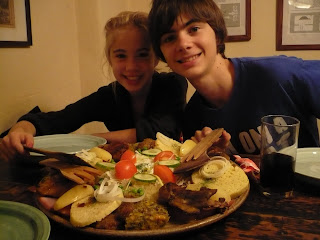Today dawned bright and sunny so we got out early to enjoy the day. 
When the clock rang, I focused the camera and took a movie. Yes, I took a movie with my very own camera. 
As I failed to get a video of the action, let me reconstruct the scene in a play by play. There were actually two tiers of characters and the top tier moved first with jousters coming around to charge each other two times. The second time one hit the other and he fell back slightly. That was good. Then the bottom tier moved. The characters spun around dancing to the music. The whole episode had to have been about 8 minutes long, including the musical prelude I videoed for you. Can you imagine every day for 600 years or however long the dang thing has been there? No wonder it only does its thing twice now.
 The first picture is the banquet hall. The raised platform is where the king would eat. There was another room where there was a long dining table with elegant chairs placed only on one side. It seems that in the 16th - 18th centuries the royalty would eat in public. Every so often, on special occasions you could come to see the royalty eat. Isn't that hilarious? You could watch them use their cutlery, choose whom to talk to and when, watch how they drank from their glasses and so on. It was all very well rehearsed. I suppose it was a kind of early version of Emily Post.
The first picture is the banquet hall. The raised platform is where the king would eat. There was another room where there was a long dining table with elegant chairs placed only on one side. It seems that in the 16th - 18th centuries the royalty would eat in public. Every so often, on special occasions you could come to see the royalty eat. Isn't that hilarious? You could watch them use their cutlery, choose whom to talk to and when, watch how they drank from their glasses and so on. It was all very well rehearsed. I suppose it was a kind of early version of Emily Post. The bedroom here they had only for show. No one ever slept here. When guests came, they saw this as they moved through the house. Behind the bed, the hangings were embroidered with silver thread making a glittering compliment to the gilt of the walls and ceiling. Over time, the thread has oxidized so it now lacks the same punch it used to have but you get the idea. Isn't this nice? A
The bedroom here they had only for show. No one ever slept here. When guests came, they saw this as they moved through the house. Behind the bed, the hangings were embroidered with silver thread making a glittering compliment to the gilt of the walls and ceiling. Over time, the thread has oxidized so it now lacks the same punch it used to have but you get the idea. Isn't this nice? A  bedroom just for show.
bedroom just for show. I also learned about religious relics. We saw the Christ doll when we were in Prague and I had difficulty understanding why it was so important. The audio-guide here explained that the Catholics believed that if you prayed to a relic, the saint attached to that relic would hear you and miracles could also occur through relics. The more relics you had, the better your chances for a miracle. It also raised your status so it was important for kings to gather as many as possible. Especially good were things like a piece of the cross on which Christ was crucified or the robe he wore and so on.
It was a lovely day. Tomorrow it is supposed to snow again. We are off to Hopferau, a little village a couple of hours west of Munich. We’re going to try to drive so I’m sure there will be exciting stories ahead!



































